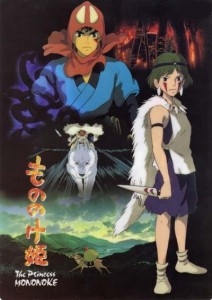 “Narrator: In ancient times, the land lay covered in forests, where, from ages long past, dwelt the spirits of the gods. Back then, man and beast lived in harmony, but as time went by, most of the great forests were destroyed. Those that remained were guarded by gigantic beasts who owed their allegiances to the Great Forest Spirit. For those were the days of gods and of demons…”
“Narrator: In ancient times, the land lay covered in forests, where, from ages long past, dwelt the spirits of the gods. Back then, man and beast lived in harmony, but as time went by, most of the great forests were destroyed. Those that remained were guarded by gigantic beasts who owed their allegiances to the Great Forest Spirit. For those were the days of gods and of demons…”
Hayao Miyazaki wrote of medieval Japan at the dawn of the Iron Age. He beautifully told a tale of the gods that owned the forests, and the men who sought their riches. While the story seems simple, he went well beyond good and evil, and talked about the hearts of men, and the ambitions and consequences of our choices. And he does this in one of the most visually stunning and beautiful films I have ever seen.
Mononoke Hime, which translates literally to Princess of spirits, is the tale of a young prince whom is cursed while protecting his home. Doomed to die, he seeks out the old gods of the forests to lift the curse and attempt to understand what is happening to the old gods. His travels leads him into a land ravaged by war as different factions are attempting to take the riches found in the forests. The gods of the forest seek to retain their home, while the humans seek to either encroach further upon these lands or to take the land already claimed by others.
The film is violent and brutal, showing characters getting their arms shot off and heads decapitated, but it does it to show how brutal war is. Miyazaki delves into deeply philosophical topics in many of his films, and Mononoke Hime is a look at the war between humans and nature. It looks at the fantastical angle of the gods of the forests and how they would protect, and fight for their home. In war, blood and death is inevitable. However, even in the midst of carnage, beauty can be seen and love can be found. Miyazaki said it best in the project proposal: “There cannot be a happy ending to the fight between the raging gods and humans. However, even in the middle of hatred and killings, there are things worth living for. A wonderful meeting, or a beautiful thing can exist. We depict hatred, but it is to depict that there are more important things. We depict a curse, to depict the joy of liberation.”
While I can’t, and never will be able to create such a beautiful world that Miyazaki does, I do consider it a great study for an author. The conflict is created early and is maintained throughout the film. Each character has their own personality with their own motivations. The world, despite the fantastical elements, feels real and alive. And at the end, when death is all around and you see the characters that have grown and gained something new and wonderful are about to sacrifice everything for their ideals, beauty and new life come forth.
The film ends leaving the viewer satisfied. Promises made have been resolved while still maintaining a realism that defies the usual moral boundaries you usually receive in animated works. The humans won the war, despite taking on the gods themselves. The princess talks of how the forests might return, but they will not belong to the gods. Even the new love has trouble bridging the two worlds leaving a gap between them that may never fully be breached. It’s not a fairy tale, but it is a tale of magic, beauty, and wonder. It is a tale we should all strive to tell.
